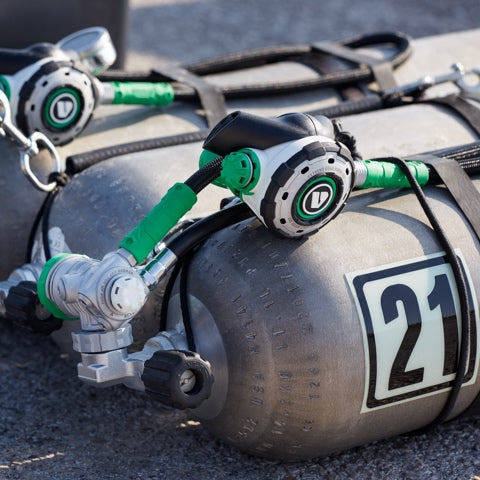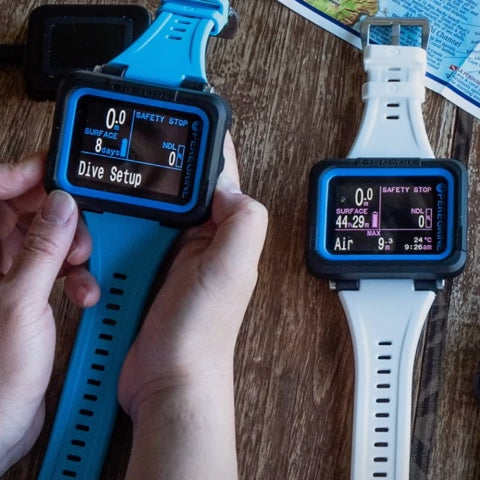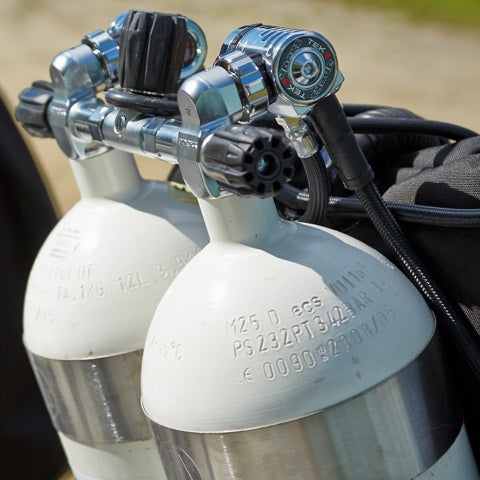Enhanced Comfort and Safety
Simply put, a drysuit P-valve, or Pee Valve, is a device that allows divers to urinate underwater while wearing a drysuit.
The valve is more like a one-way drysuit dump valve, and the system both for male and female divers is named after the valve itself as a P-Valve. Male divers use catheters, whereas female divers use the She-P for attachment.
The only difference between the two is the material, shape and functionality of the part that attaches to the body, considering anatomical differences.
Below is the silicone She-P attachment (L) for female divers and the catheter for male divers.


The P-Valve is a discharge system with a one-way external valve attached to the outside of the drysuit, normally on the inner thigh.
Installation involves creating a small hole in the drysuit, applying silicone to the valve, and securing it in place. Connected to the valve is a tube that extends to the genital area, accommodating both male and female divers.
Below you can see the two main P-Valves we stock, together with components we supply both for male and female divers.
As explained, male divers wear a catheter that attaches to the urination tube, completing the connection to the drysuit before donning the upper body. Female divers wear the safe She-P connector for the same purpose.
Once attached, divers can easily urinate into the catheter/She-P, and the urine flows through the tube, exits the valve, and enters the water.
This straightforward system enhances comfort and is particularly useful for preventing dehydration.
Above and beyond being incredibly convenient for a comfortable dive, P-valves are an important safety device for divers using drysuits. They allow divers to properly hydrate before diving without being concerned about urinating on the dive.
Divers Alert Network (DAN) recommends drinking a glass of water every 15-20 minutes prior to diving rather than drinking a litre of water just before or after a dive. This is because tissues need to be properly hydrated to avoid the risk of DCS.
P-valves allow divers to stay hydrated, eliminating the fear of urinating during a dive, which makes them an essential safety tool for all drysuit divers.
Factors to consider
There are two main types of P-valves: balanced and unbalanced. Balanced valves have a small hole in the side that allows air to enter the tube, equalising the pressure inside the tube with the ambient pressure. This prevents the tube from collapsing or kinking during the dive.
Unbalanced valves do not have this hole, and the pressure inside the tube can build up as the diver descends. This can make it difficult to urinate for drysuit divers, which are more suitable for installation in wet suits.
Another factor for male and female divers to consider is the quality of the urination tubing used under the drysuit. Some manufacturers may utilise surgical tubing-type softer and more flexible hoses that are more prone to kinks.
Our own preference would be sturdy yet still flexible fuel-line type tubing as used by leading P-Valve manufacturers Halcyon, Apeks and OMS.
P-Valve and She-P Tips
Our most important tip for male and female divers using a P-valve/She-P for the very first time is:
"Be modest but don’t be shy about it!"
Some of us remember the days just a few decades ago when we’d have to dive and have surface time in adult diapers during deeper, longer dives (and products those days were nowhere close to the current absorbent technology available). The only other alternative then was the so-called “relief zipper” for male divers that could only be used for surface relief.
One more tip for male and female divers alike is that body hair can interfere with a reliable seal, and where in contact with whatever the attachment, hair may need to be trimmed or removed.
While we're on tips, the most common two mistakes appear to be forgetting to open the P-valve when relieving oneself and/or forgetting to attach the system to the body - result: a cold, wet experience.
The most important thing is to keep the tube and valve clean against many bacteria and debris collecting over time. Bacteria is the main concern as it can lead to urinary tract infections, which are painful and dangerous. This can be done in many ways with off-the-shelf products ranging from alcohol to vinegar and water mixtures, substances like Dettol. Rinsing with fresh water after cleaning will lead to a healthy dive.
Catheter Tips for Male Divers
Catheter SIZE matters: Most male divers will start with medium-size catheters, which is why we regularly stock boxes and boxes of 29 and 32mm ones.
If you’re using a P-Valve for the first time, there is –believe it or not—a size chart cut-out based on diameter. But a more modest way to go about size is to order one of each size and use them, taking into underwater factors that can affect size and seal, including squeeze and perspiration.

Catheter QUALITY matters: While catheters are primarily made for surface use and are medical supplies mostly for incontinence issues, there are different manufacturers with different quality catheters. Through years of experience and feedback from fellow divers, our preferred and most reliable catheter is the BARD Wideband Self-Adhering Male External Catheter, which can be purchased stand-alone or in boxes of 30 (of the same size).

Catheter CONNECTION matters: Halcyon, Apeks and OMS use robust but flexible rubber hoses as their urination tubes. Of the three, only Apeks uses a male-female quick-release attachment at the catheter end of the tubing. Both Halcyon and OMS have a single black nipple at the end of the tube to attach a catheter to. We strongly recommend removing the nipple and replacing it with the two-piece P-Valve Quick Disconnector.
Preparing the Catheter: As catheters are made for surface use, the connection point is deliberately made long. While this length may make it easier on the surface, it can bend, fold or kink under a drysuit, preventing flow and leading to an unhealthy build-up or backlash of urine. We strongly recommend trimming down the length, leaving a space of about one centimetre between the end of the catheter and its attachment.
General Tips
Using the P-Valve Quick Disconnector: The bulky female side of the connector goes into the urination tube and lives there as a replacement for any previous connector. Take out the catheter, trim the connecting end as above with scissors, and then attach the male end of the connector to the catheter.
Prior to putting the catheter on, ensure your skin is dry. Don’t forget that moisture and perspiration can cause a catheter to become unattached to the skin, as well as exercise and excessive movement. You can now put the catheter on, similar to unrolling a condom.
Once on, you can attach the plastic male connector end to the female connector end of the tube. In between dives, you can disengage from the tube and connect back before the next dive. Multiple long dives may require changing the catheter due to movement.
Make Life Easy: There is no one way to route the tube from the discharge valve to the catheter but in any event, due to its location, the tube will naturally be facing up in the first place. Some will connect themselves facing down, others facing up. Assuming most of a dive is going to be in a horizontal body position, it does make sense to bend the end of the tube down onto a catheter facing up under the undersuit.. This will bend the tube in a ∩ shape that allows unrestricted flow during a dive. Better still, it also allows for discreet attachment even in crowded environments, with only the plastic parts of a quick disconnector visible briefly as you plug yourself in and out.
Use it As You Need: There will likely be many different experiences and views out there, but from practice, we’d suggest you use the P-Valve as you feel the need to urinate as opposed to what you’d do on the surface and avoid waiting for an opportunity to urinate or holding it back. Don’t hold back; do it when you need to.
Open or Closed? The discharge valve operates like a drysuit dump valve and can (should) be closed, especially on longer, deeper dives, as a measure against any failure. But it is a one-way valve system, and on shallower dives, we’ve not encountered any problems leaving it partially open enough to allow an outward flow when required.
A P-Valve is how to stay hydrated, stay comfortable in the water, and not “depend” on diapers. It enhances dive safety and comfort.
SAFE AND DRY DIVING!




































